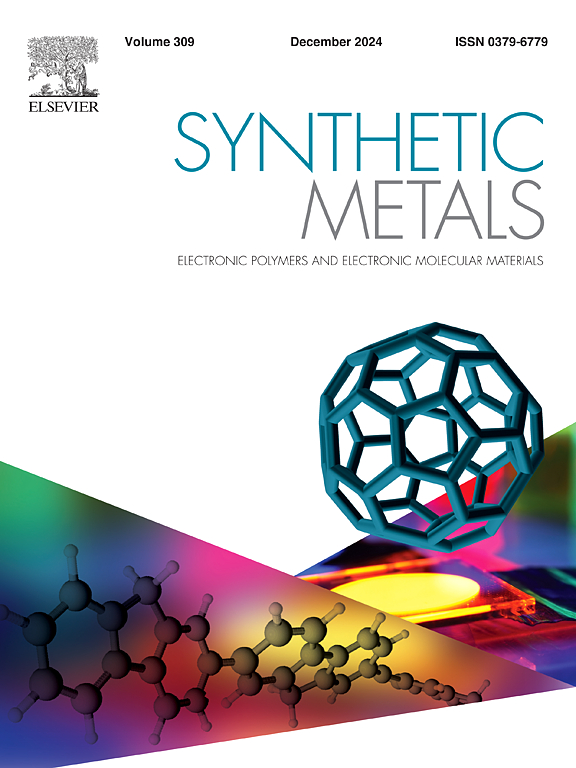采用F和N共掺杂氧化石墨烯/聚苯胺作为孔提取层,铜纳米线作为透明导电电极的全印刷有机光伏
IF 4.6
3区 材料科学
Q2 MATERIALS SCIENCE, MULTIDISCIPLINARY
引用次数: 0
摘要
有机光伏(OPVs)具有灵活和轻量化太阳能应用的巨大前景;然而,它们的长期稳定性和效率仍然受到界面层性能的限制。特别是,广泛使用的孔提取层(HEL)材料PEDOT:PSS具有固有的酸度和水分敏感性,这对器件的寿命有不利影响。在这项研究中,我们报道了一种基于氟和氮共掺杂氧化石墨烯-聚苯胺(FNGO/PANI)的新型HEL,在掺杂氧化石墨烯的存在下,在酸性条件下通过苯胺的原位氧化聚合合成。共掺杂策略调节了氧化石墨烯的能带结构,在保持载流子迁移率的同时,实现了能带隙的形成和有利的能级排列。FNGO/PANI复合材料具有优异的薄膜均匀性,溶液可加工性以及与低温退火(120°C)的兼容性,使其适用于柔性基板和可扩展制造。当集成到使用铜纳米线(Cu NW)透明导电电极和传统体异质结有源层的全印刷opv时,以FNGO/PANI为HEL的器件实现了16.90 mA cm⁻²的短路电流密度(Jsc), 0.80 V的开路电压(Voc), 69.82 %的填充因子(FF)和9.44 %的功率转换效率(PCE)。这些结果表明,与单独使用FNGO的器件相比,这是一个显著的改进,并证明了共掺杂和聚合物集成的协同效益。这一发现突出了FNGO/PANI作为下一代全印刷OPV技术的高性能、可解决方案可处理HEL的潜力。本文章由计算机程序翻译,如有差异,请以英文原文为准。
Fully printed organic photovoltaic employing F and N co-doped graphene oxide/polyaniline as hole extraction layer and copper nanowires as transparent conductive electrode
Organic photovoltaics (OPVs) hold great promise for flexible and lightweight solar energy applications; however, their long-term stability and efficiency remain constrained by the performance of interfacial layers. In particular, the widely used hole extraction layer (HEL) material, PEDOT:PSS, suffers from intrinsic acidity and moisture sensitivity, which adversely affect device longevity. In this study, we report a novel HEL based on fluorine and nitrogen co-doped graphene oxide-polyaniline (FNGO/PANI) synthesized via in situ oxidative polymerization of aniline in the presence of doped graphene oxide under acidic conditions. The co-doping strategy modulates the band structure of graphene oxide, enabling bandgap formation and favorable energy-level alignment while preserving carrier mobility. The FNGO/PANI composite exhibits excellent film uniformity, solution processability, and compatibility with low-temperature annealing (120 °C), making it suitable for flexible substrates and scalable fabrication. When integrated into fully printed OPVs utilizing copper nanowire (Cu NW) transparent conductive electrodes and a conventional bulk heterojunction active layer, devices incorporating FNGO/PANI as the HEL achieve a short-circuit current density (Jsc) of 16.90 mA cm⁻², open-circuit voltage (Voc) of 0.80 V, fill factor (FF) of 69.82 %, and a power conversion efficiency (PCE) of 9.44 %. These results represent a significant improvement over devices using FNGO alone and demonstrate the synergistic benefits of co-doping and polymer integration. The findings highlight the potential of FNGO/PANI as a high-performance, solution-processable HEL for next-generation, fully printed OPV technologies.
求助全文
通过发布文献求助,成功后即可免费获取论文全文。
去求助
来源期刊

Synthetic Metals
工程技术-材料科学:综合
CiteScore
8.30
自引率
4.50%
发文量
189
审稿时长
33 days
期刊介绍:
This journal is an international medium for the rapid publication of original research papers, short communications and subject reviews dealing with research on and applications of electronic polymers and electronic molecular materials including novel carbon architectures. These functional materials have the properties of metals, semiconductors or magnets and are distinguishable from elemental and alloy/binary metals, semiconductors and magnets.
 求助内容:
求助内容: 应助结果提醒方式:
应助结果提醒方式:


